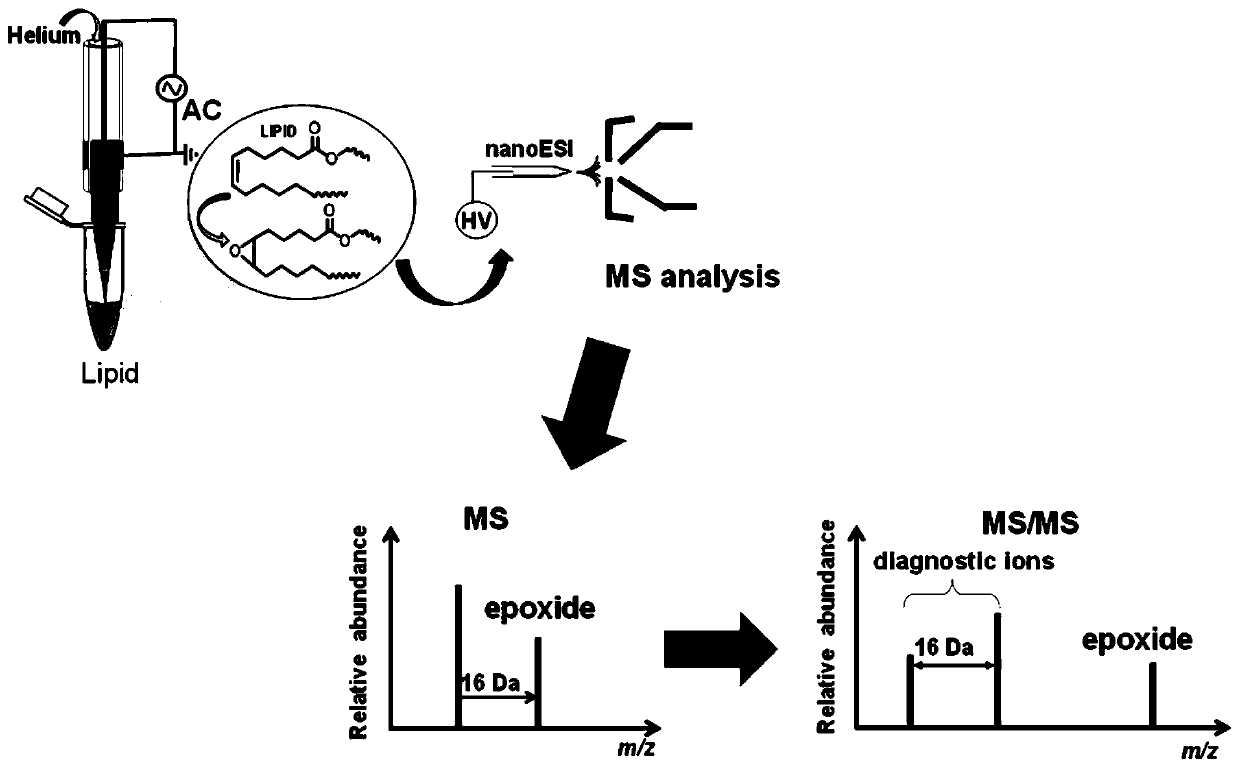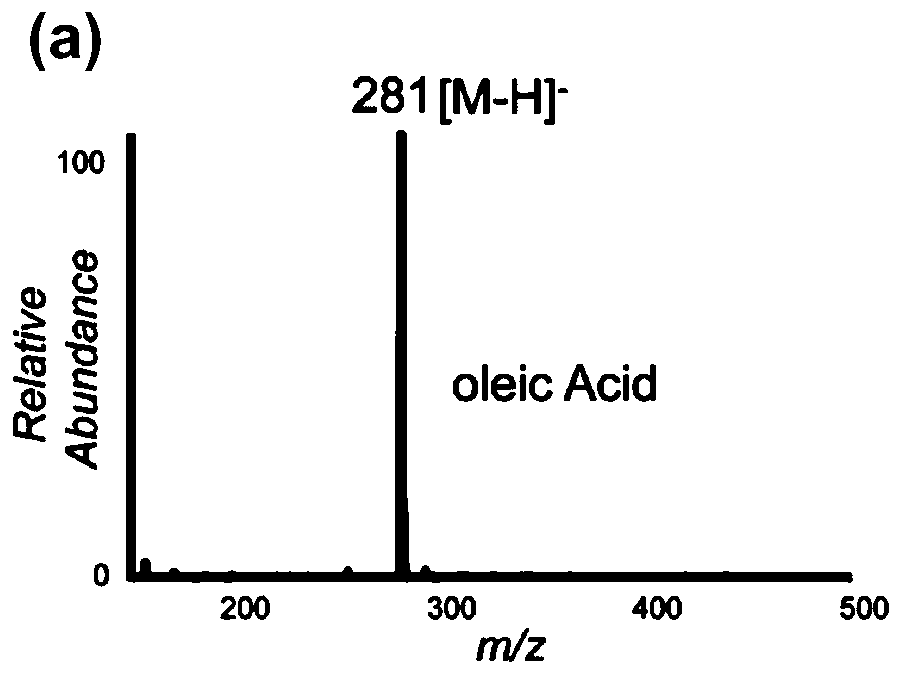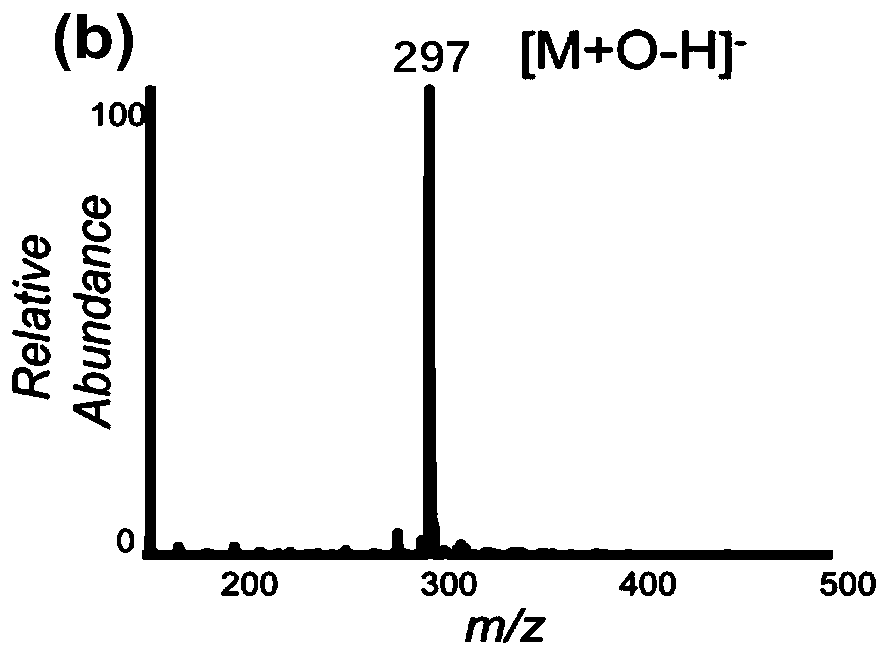Method for authenticating unsaturated lipid carbon-carbon double bond position based on epoxidation and mass spectrum
A carbon-carbon double bond, unsaturated fatty acid technology, applied in the field of mass spectrometry analysis, can solve problems such as the yield of side reactions, and achieve the effects of simple and easy method, high yield, and improved detection sensitivity and quantitative accuracy.
- Summary
- Abstract
- Description
- Claims
- Application Information
AI Technical Summary
Problems solved by technology
Method used
Image
Examples
Embodiment 1
[0038] This example identifies C=C positions in unsaturated fatty acids based on the present invention. The identification method is as follows: acetone is used as the organic solvent, and the standard product of fatty acid (FA) is oleic acid (Oleic Acid), namely FA 18:1 (9Z); sample pretreatment: acetone: water (volume ratio: 50 / 50) ) to dilute the sample concentration to 10 μmolar. LTP device: LTP probe adopts quartz glass tube (outer diameter 4mm, inner diameter 2mm), inner electrode adopts copper needle electrode, and outer electrode adopts copper tape ring electrode. Pass the carrier gas (helium gas, the flow rate is 1.5L / min), pass the alternating current (the voltage peak-to-peak value is 3.5~4.5kV, the frequency is 16kHz) to generate LTP. Lipid epoxidation derivatization: The epoxidation derivatization reaction was completed by purging the lipids with the LTP plume for 20s. The LTQ mass spectrometer of Thermo Company was selected, and the nanospray ion source was use...
Embodiment 2
[0040] This example identifies C=C positions in unsaturated phospholipids based on the present invention. The identification method is as follows: the standard of phosphatidylcholine (PC) is PC 16:0 / 18:1 (9Z). Sample preparation: Dilute the sample concentration to 10 μM using acetonitrile as the organic solvent. LTP device: LTP probe adopts quartz glass tube (outer diameter 4mm, inner diameter 2mm), inner electrode adopts copper needle electrode, and outer electrode adopts copper tape ring electrode. Pass the carrier gas (helium gas, the flow rate is 1.5L / min), pass the alternating current (the voltage peak-to-peak value is 3.5~4.5kV, the frequency is 16kHz) to generate LTP. Lipid epoxidation derivatization: The epoxidation derivatization reaction was completed by purging the lipids with the LTP plume for 20s. The Impact Q-TOF mass spectrometer of Bruker Company is selected, and the nanospray ion source is used to detect in the positive mode, and the positive mode detects th...
Embodiment 3
[0042] This example identifies C=C positions in unsaturated phospholipids based on the present invention. The identification method is as follows: the standard of phosphatidylcholine (PC) is PC 16:0 / 18:1 (9Z). Sample preparation: Use acetonitrile (containing 30 mmol of ammonium acetate) as the organic solvent to dilute the sample concentration to 10 μmol. LTP device: LTP probe adopts quartz glass tube (outer diameter 4mm, inner diameter 2mm), inner electrode adopts copper needle electrode, and outer electrode adopts copper tape ring electrode. Pass the carrier gas (helium gas, the flow rate is 1.5L / min), pass the alternating current (the voltage peak-to-peak value is 3.5~4.5kV, the frequency is 16kHz) to generate LTP. Lipid epoxidation derivatization: The epoxidation derivatization reaction was completed by purging the lipids with the LTP plume for 20s. The mass spectrometer used in this example is the Qtrap4500 of Sciex Company, and the nanospray ion source is used to detec...
PUM
 Login to View More
Login to View More Abstract
Description
Claims
Application Information
 Login to View More
Login to View More - R&D
- Intellectual Property
- Life Sciences
- Materials
- Tech Scout
- Unparalleled Data Quality
- Higher Quality Content
- 60% Fewer Hallucinations
Browse by: Latest US Patents, China's latest patents, Technical Efficacy Thesaurus, Application Domain, Technology Topic, Popular Technical Reports.
© 2025 PatSnap. All rights reserved.Legal|Privacy policy|Modern Slavery Act Transparency Statement|Sitemap|About US| Contact US: help@patsnap.com



